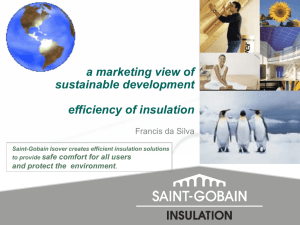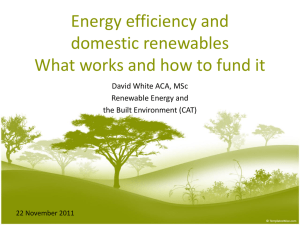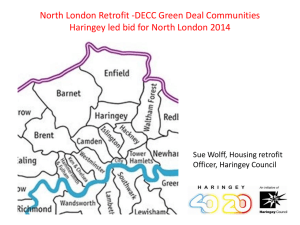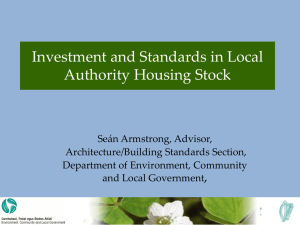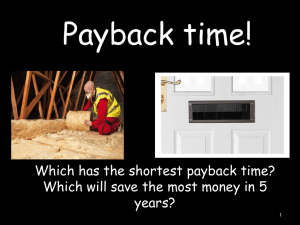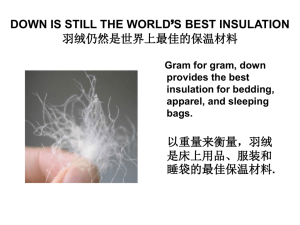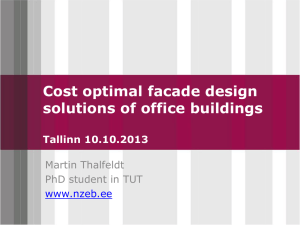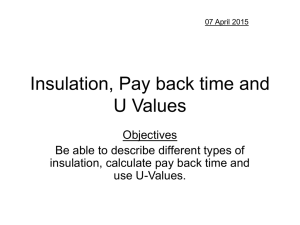Why Retrofit?
advertisement
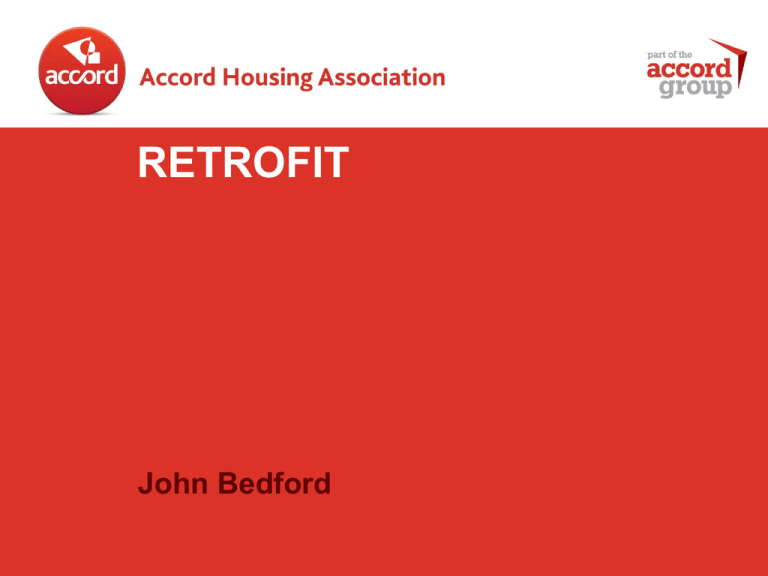
RETROFIT John Bedford Why Retrofit? • The UK’s 26 million homes are responsible for 14% of it’s greenhouse gas emissions. • The Government target is to cut emissions by at least 34% by 2020 and 80% by 2050 (compared to 1990 levels) by increasing efficiency of our housing stock. • Around three quarters of the housing stock that will exist in 2050 has already been built • Retrofitting existing housing will make the most difference most quickly. Why Retrofit? Reduce Energy = Reduce Costs! •Smaller energy bills •Smaller carbon footprint •More comfortable home First Steps Fuel Source Reduce Demand Fabric Kyoto Pyramid How? • Loft insulation • Cavity wall insulation • Solid wall insulation • Ground floor insulation • Double glazing • Draught proofing • Energy efficient A rated condensing boilers • Energy saving light bulbs • On site energy generation? On Site Energy Generation Most common types:Solar Photovoltaics Solar Water (Collectors) Wind Bio Mass Air Source Ground Source Combined Heat and Power Before investing in one of these technologies find out how much energy you use and do as much as you can to reduce it! Insulation Around 50% of the heat losses of a house are through the walls and roof. • Loft insulation – recommended depth 270mm. • Installed cost £250 (DIY cost from £50) • Payback 2 – 3 years: saving on energy bill £145 per year • CO2 saving 730kg • Cavity wall insulation • Installed cost £250 • Payback 2 years: saving on energy bill £110 • CO2 saving 560kg Insulation cont’d •Solid wall insulation Internal •Installed cost £5,500 - £8,500 •CO2 saving 1.8 tonnes •Saving on energy bill £365 per year External •Installed cost £10,500 - £14,500 •CO2 saving 1.9 tonnes •Saving on energy bill £385 per year Insulation cont’d •Floor Insulation Insulation under boards •Cost is around £100 •CO2 saving 240kg •Payback in 2 years: saving on energy bill £50 per year Filling gaps between floorboards and skirting board •Cost is around £20 •CO2 saving 100kg •Payback in 1 year: saving on energy bill £20 per year Double Glazing & Draught Proofing • Double glazing cuts heat loss through windows by half and could save around £130 per year on heating bills. • Double glazing could save around 680kg CO2 compared to single glazing. • Draught proof leaky door and window frames and save around £25 per year on heating bills. Energy Efficient Equipment • A high efficiency A rated condensing boiler will convert 88% or more of its fuel to heat compared to 65% for a G rated boiler – saving around 1300kg CO2 and £235 per year • Even energy efficient white goods like fridges and washing machines can help reduce energy bills • Lighting – an energy saving bulb will use about a fifth less electricity than a standard bulb and can save around £45 before it needs replacing. Whole House Approach • The cumulative gain of all these measures will amount to savings of around £700 per year and 2930kg CO2 per year based on a ‘cavity wall’ 3 bed semi with no insulation and no double glazing. Considerations Solar Photovoltaics and Solar Thermal both harness the energy from the sun. •Is the roof southerly facing with no shading? •Can the existing structure withstand the weight of the panels? •Is there room inside the house to accommodate equipment such as an extra water tank? •Is the energy demand high enough to justify the cost of installation? Considerations cont’d Heat Pumps (air source or ground source). • Is there enough space to lay the ‘loop’ for the ground source pump? • Is there room outside the dwelling to house the unit? • Is the home insulated and draught proof? • Has the heat pump been designed / sized appropriately for the property? • Heat pumps work best with underfloor heating – can this be installed? • May not be a cost effective alternative to homes already on the gas grid. Case Study – Tindal Street •TSB funded retrofit prototype with a budget of around £142k •Building type is early 20th century mid terrace near Birmingham city centre •Hard to treat – solid walls, little insulation, single glazing, un-insulated extension and loft conversion. •Additional heat is lost through the cellar and an external wall backing on to a side Passageway. Tindal Street - Retrofit Specification •Externally insulate rear external wall and kitchen extension. •Internally insulate front external wall (to maintain external facade). •Internally insulated external wall backing onto side passageway. •Roof replaced with breathable roofing membrane and unventilated roof structure with insulation full depth of rafter. •Suspended timber floors insulated from below. •Floorboards replaced with chipboard to improve air tightness. •Insulate underside of ground floor stairs within the cellar. •Wall under stairs at ground level replaced with timber stud and infilled with insulation. •Window replaced with triple glazed argon filled units. Specification cont’d •External doors replaced with thermally insulated timber doors. •Old inefficient gas boiler replaced with ‘A’ rated combi boiler plus a Gas Saver flue gas recovery unit to improve efficiency. •Solar hot water installed with flat plate collector on forth southwest facing roof. •Gas fire in living room replaced with small wood burning stove. •Heating system controlled with innovative ‘Wattbox’ system. •Dedicated energy efficient lighting throughout. •All white goods replaced with A++ rated appliances Results •As part of Retrofit for the Future, the property will be monitored over the next 2 years and results shared. •The target is to reduce carbon emissions from the dwelling by 80%. •Total CO2 savings are expected to be around 7.5tonnes. Case Study – courtesy of ‘Energy Solutions’ One bed ground floor mansion block flat in corner location Survey Summary • Walls - solid brick, no insulation • Floor - part suspended timber, part solid • Heating - electric = high CO2 & fuel costs • Heating controls - manual • Windows - single glazed wooden sash • Doors - solid timber. •A property with solid walls and not connected to the gas grid would be deemed ‘Hard to Treat’ Applicable Measures The range of measures deemed applicable to this ‘hard to treat’ dwelling: •Internal solid wall insulation to bedroom •Replacement windows or secondary glazing •Door replacement •New ‘A’ rated gas boiler & controls (gas connection required) and radiators •100% low energy lighting •Draught proofing Analysis of Measures •Sap modelling was used to assess the measures based on their impact on CO2 emissions and annual fuel costs •Measures are ranked in terms of best value improvements resulting in largest CO2 and cost savings •Other factors include cumulative effect of measures and practical implementation •Restriction of budget is also a factor. Final Package of Measures •New gas boiler, controls and radiators •Draught proofing throughout •Low energy lights •Total cost of package £6,530 Estimated Savings from Package •56% (3312kg/year) reduction in CO2 emissions •60% (£786) reduction in annual running costs •SAP rating improved from 10 to 47 Cost •Cost effective = looks at simple payback •Cost optimal = looks at lifecycle costs or net present value of an improvement package •The cost optimal solution gives the greatest return when subtracting the installation costs from the lifetime energy savings Conclusion •Many factors will govern the level of retrofit measures carried out, not least cost. •But – even small measures can have a positive impact on finances and carbon savings.

